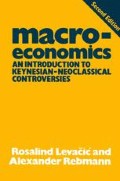Abstract
The ISLM model reduces to only two independent markets or equations and can therefore solve for just two endogenous variables: the level of real output and the interest rate in the Keynesian version; the price level and the interest rate in the neoclassical version. The introduction of the labour market provides a third independent equation and enables one to solve for all three variables: the interest rate, the price level and the quantity of real national output. This chapter outlines the three-sector macro model in which the goods, money and labour markets interact. The behavioural equations which make up the three markets can be reduced in number and summarised in the form of aggregate demand and aggregate supply functions. The aggregate demand function which is derived from the IS and LM equations takes the same basic form in both the neoclassical and Keynesian versions of the model. The fundamental difference between the two approaches lies in their specification of the supply side of the economy, as we have just seen in Chapter 5.
Preview
Unable to display preview. Download preview PDF.
References
J. R. Hicks, ‘Mr Keynes and the Classics: A Suggested Interpretation’, Econometrica 5, 2 (1937).
A. Hansen, A Guide to Keynes (New York: McGraw-Hill, 1953).
F. Modigliani, ‘Liquidity Preference and the Theory of Interest and Money’, Econometrica, 12 (1944).
A.C. Pigou, ‘The Classical Stationary State’, Economic Journal, 53 (December 1943).
J. G. Gurley and E. S. Shaw, Money in a Theory of Finance (Washington, D.C.: Brookings Institution, 1966).
L. A. Metzler, ‘Wealth, Saving and the Rate of Interest’, Journal of Political Economy, 59 (April 1951).
W. Smith, ‘Current Issues in Monetary Economics’, Journal of Economic Literature, 8, 3 (September 1970).
R. A. Mundell, ‘The Public Debt, Corporate Income Taxes and the Rate of Interest’, Journal of Political Economy, 60 (1960).
B. P. Pesek and T. R. Saving, Money, Wealth and Economic Theory (New York: Macmillan, 1967).
D. Patinkin, ‘Money and Wealth: A Review Article’, Journal of Economic Literature, 7 (1969).
D. Patinkin, ‘Price Flexibility and Full Employment’, originally published in American Economic Review, 38 (1948), revised version in Readings in Monetary Theory, ed. American Economic Association (New York: Blakiston, 1962).
J. Tobin, Asset Accumulation and Economic Activity (Oxford: Blackwell, 1980) 9–11.
J. Hicks, ‘What is Wrong with Monetarism?’, Lloyds Bank Review, 118 (October 1975).
Copyright information
© 1982 Rosalind Levačić and Alexander Rebmann
About this chapter
Cite this chapter
Levačić, R., Rebmann, A. (1982). The Three-Sector Macro Model. In: Macroeconomics. Palgrave, London. https://doi.org/10.1007/978-1-349-86044-9_6
Download citation
DOI: https://doi.org/10.1007/978-1-349-86044-9_6
Publisher Name: Palgrave, London
Print ISBN: 978-0-333-34145-2
Online ISBN: 978-1-349-86044-9
eBook Packages: Palgrave Economics & Finance CollectionEconomics and Finance (R0)

